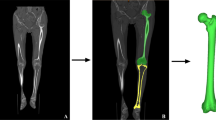Abstract
Our objective was to assess and validate low-dose computed tomography (CT) scanogram as a post-operative imaging modality to measure the mechanical axis after navigated total knee replacement. A prospective study was performed to compare intra-operative and post-operative mechanical axis after navigated total knee replacements. All consecutive patients who underwent navigated total knee replacement between May and December 2006 were included. The intra-operative final axis was recorded, and post-operatively a CT scanogram of lower limbs was performed. The mechanical axis was measured and compared against the intra-operative measurement. There were 15 patients ranging in age from 57 to 80 (average 70) years. The average final intra-operative axis was 0.56° varus (4° varus to 1.5° valgus) and post-operative CT scanogram axis was 0.52° varus (3.1° varus to 1.8° valgus). The average deviation from final axes to CT scanogram axes was 0.12° valgus with a correlation coefficient of 0.9. Our study suggests that CT scanogram is an imaging modality with reasonable accuracy for measuring mechanical axis despite significantly low radiation. It also confirms a high level of correlation between intra-operative and post-operative mechanical axis after navigated total knee replacement.
Résumé
Cette étude a pour but d’analyser et d’évaluer les images scanner et les modalités des clichés post-opératoires après prothèse totale du genou implantée avec navigation.
Matériel et méthode: une étude prospective a été réalisée pour comparer les axes mesurés en per et post-opératoire, après navigation, chez les patients ayant bénéficié d’une prothèse totale du genou avec navigation et inclus de mai à décembre 2006. Les axes per et post-opératoires ont été rapportés et comparés avec l’axe mécanique obtenu et mesuré en per-opératoire.
Résultats: 15 patients d’âge moyen de 70 ans (57 – 80 ans) ont été analysés. L’axe final per-opératoire a été de 0.52° varus (4° à 1,5°) et, l’axe post-opératoire mesuré par scanner a été de 0.52° varus (3,1° à 1,8°). La déviation axiale médiane est de 0.12° valgus avec un coefficient de corrélation de 0,9.
En conclusion, notre étude permet de penser que le scanner est une modalité d’évaluation raisonnable de mesure de l’axe mécanique en dépit d’une irradiation significative mais néanmoins assez basse. Cette étude permet également de confirmer un haut niveau de corrélation entre la mesure de l’axe per-opératoire et la mesure de l’axe post-opératoire dans les prothèses totales du genou avec navigation.


Similar content being viewed by others
References
Bargren JH, Blaha JD, Freeman MA (1983) Alignment in total knee arthroplasty. Correlated biomechanical and clinical observations. Clin Orthop Relat Res 173:178–183
Bellemans J, Banks S, Victor J, Vandenneucker H, Moemans A (2002) Fluoroscopic analysis of the kinematics of deep flexion in total knee arthroplasty. Influence of posterior condylar offset. J Bone Joint Surg Br 84:50–53
Chauhan SK, Clark GW, Lloyd S, Scott RG, Breidahl W, Sikorski JM (2004) Computer-assisted total knee replacement. A controlled cadaver study using a multi-parameter quantitative CT assessment of alignment (the Perth CT Protocol). J Bone Joint Surg Br 86(6):818–823
Chauhan SK, Scott RG, Breidahl W, Beaver RJ (2004) Computer-assisted knee arthroplasty versus a conventional jig-based technique. A randomised, prospective trial. J Bone Joint Surg Br 86:372–377
Chiu KY, Yau WP, Ng TP, Tang WM (2008) The accuracy of extramedullary guides for tibial component placement in total knee arthroplasty. Int Orthop 32:467–471
Graydon AJ, Malak S, Anderson IA, Pitto RP (2008) Evaluation of accuracy of an electromagnetic computer-assisted navigation system in total knee arthroplasty. Int Orthop. May 28. [Epub ahead of print]
Haaker R, Stockheim M, Kamp M, Proff G, Breitenfelder J, Ottersbach A (2005) Computer-assisted navigation increases precision of component placement in total knee arthroplasty. Clin Orthop Relat Res 433:152–159
Hart D, Millier MC, Wall BF, Shrimpton PC, Bungay D (1995) Doses to patients from medical X-ray examinations in the UK 1995 review, NRPB-R289. Her Majesty’s Stationary Office, London, pp 199–201
Hofmann S, Romero J, Roth-Schiffl E, Albrecht T (2003) Rotational malalignment of the components may cause chronic pain or early failure in total knee arthroplasty (in German). Orthopade 32:469–476
Henckel J, Richards R, Lozhkin K, Harris S, Baena FM, Barrett AR, Cobb JP (2006) Very low-dose computed tomography for planning and outcome measurement in knee replacement. The imperial knee protocol. J Bone Joint Surg Br 88:1513–1518
Jeffery RS, Morris RW, Denham RA (1991) Coronal alignment after total knee replacement. J Bone Joint Surg Br 73:709–714
Jessup DE, Worland RL, Clelland C, Arredondo J (1997) Restoration of limb alignment in total knee arthroplasty: evaluation and methods. J South Orthop Assoc 6(1):37–47
Jonsson B, Astrom J (1988) Alignment and long-term clinical results of a semiconstrained knee prosthesis. Clin Orthop Relat Res 226:124–128
Kuzhupilly RR, Seferiadis I, Lennox IA (2008) Optimising femoral component rotation using Equiflex instrumentation: a clinical review. Int Orthop 32(3):345–353
Lotke PA, Ecker ML (1977) Influence of positioning of prosthesis in total knee replacement. J Bone Joint Surg Am 59:77–79
Rand JA, Coventry MB (1988) Ten-year evaluation of geometric total knee arthroplasty. Clin Orthop Relat Res 232:168–173
Stulberg SD, Loan P, Sarin V (2002) Computer-assisted navigation in total knee replacement: results of an initial experience in thirty-five patients. J Bone Joint Surg Am 84:90–98
Victor J, Hoste D (2004) Image-based computer-assisted total knee arthroplasty leads to lower variability in coronal alignment. Clin Orthop Relat Res 428:131–139
Author information
Authors and Affiliations
Corresponding author
Rights and permissions
About this article
Cite this article
Mohanlal, P., Jain, S. Assessment and validation of CT scanogram to compare per-operative and post-operative mechanical axis after navigated total knee replacement. International Orthopaedics (SICOT) 33, 437–439 (2009). https://doi.org/10.1007/s00264-008-0639-3
Received:
Revised:
Accepted:
Published:
Issue Date:
DOI: https://doi.org/10.1007/s00264-008-0639-3




